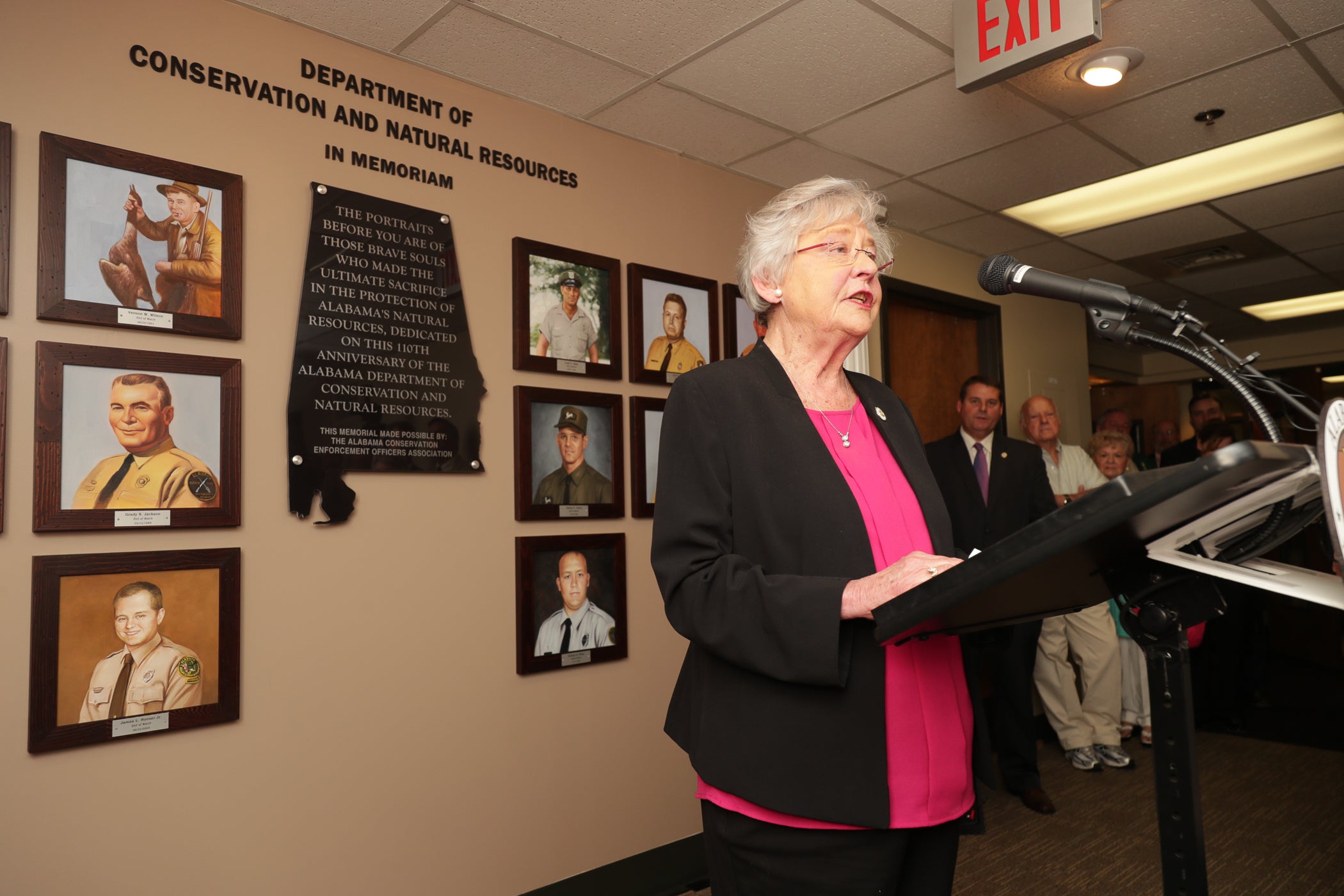By DAVID RAINER, Alabama Department of Conservation and Natural Resources
What started as an idea to honor the greatest sacrifice a conservation enforcement officer can make blossomed into a capacity-crowd commemoration of 12 game wardens who gave their lives in the line of duty during the 110-year history of the Alabama Department of Conservation and Natural Resources (DCNR).
Governor Kay Ivey, Conservation Commissioner Chris Blankenship and Matt Weathers, Wildlife and Freshwater Fisheries (WFF) Division Enforcement Chief, shared their appreciation for the officers’ sacrifices as DCNR celebrated its birthday.
Weathers said when he became head of Enforcement a year ago, one of his priorities was to come up with some way to honor the officers who have lost their lives on duty.
“This is a long overdue honor of your friends, family and coworkers,” Weathers told the crowd that filled the halls on the fifth floor of the Folsom Building in Montgomery. “I’m overjoyed to see this turnout.
“The first thing on my list was to honor the men who had given all they had so that the state could continue to enjoy the natural-resource wealth it has, to protect it from the rampant commercialization that has persisted.”
Weathers said he considered several options to honor the officers, including a statue or plaques, but soon realized portraits would be the best option.
“I couldn’t stand the thought of speaking to you without having these guys looking over my shoulder,” he said. “When this is all over, I think we’ll all agree we couldn’t imagine having this dedication in any other location.”
Weathers said he came to understand what family meant when he joined WFF two decades ago after serving as a police officer for several years.
“It was a lifelong, childhood dream to be a game warden,” he said. “I thought I knew what a work family was about, what having brothers and sisters I would die for was about. When I got to Game and Fish, which is what we called it in those days, I realized there was a deeper meaning to family within this agency. As a young officer, not really knowing what I was doing, that I could pick up a radio or telephone at 3 o’clock in the morning and could call an officer in Limestone County or in Baldwin County. They would get out of bed and do anything it took to get me the information to get the help I needed.
“I had found a home. I had found people that I may not ever see or see them on a day-to-day basis who would go to bat for me and get me through any situation. It’s family.”
Weathers also said the loved ones and friends of those who died in the line of duty would always be members of the Conservation family.
“Their names are forever etched on the history of this organization and will be forever,” he said. “To the families, thank you for giving those men to us. They missed Little League games. They missed birthdays and school functions. It’s part of the job. Thank you for giving them to us. They serve a goal, a mission, that is greater than any one person.”
Governor Ivey read the names of the men who are memorialized on the WFF wall. They are: George S. Wilson, 1922, Montgomery County; Bart Cauley, 1932, Baldwin County; Vernon W. Wilson, 1951, Randolph County; Lloyd C. Hays, 1964, Morgan County; John Roy Beam, 1976, Marshall County; Frank Stewart Jr., 1978, Escambia County; Cecil Craig Chatman, 1982, Lowndes County; Grady R. Jackson, 1984, Pike County; James C. Vines, 1985, Greene County; Jimmy D. Hutto, 2002, Fayette County; James Lance Horner Jr., 2003, Clarke County; and Nathan B. Mims, 2008, Chilton County.
“I’m honored to be with you as we celebrate the history of the Department of Conservation and the 110 years since it was formed,” Governor Ivey said. “We’re also celebrating the folks who continue to work today to keep our state beautiful and our wildlife healthy and protected. The men and women of this Department do a great service for the people of Alabama, and we want to thank you for your good service. All of us in state government have the same goal. We want to work hard to make our state better for not only now but also future generations.”
Governor Ivey recalled the history of the Department of Conservation since it was formed in the Legislature by resolution from Representative John Wallace, who went on to become Conservation’s first commissioner. Commissioner Wallace appointed a game warden for each of Alabama’s 67 counties.
“From its beginning, the Department has been committed to protecting and conserving wildlife and the natural beauty for our state and generations to come to enjoy,” she said. “As citizens of Alabama the beautiful, it is our job to help keep it that way.
“From the very beginning, God told mankind to take care of the earth. And with the efforts of the men and women who work in the Department of Conservation and Natural Resources, you are helping us fulfill that responsibility. This state is so very special. We are proud to live here. We call it home. We are grateful for you protecting what God has given us.”








